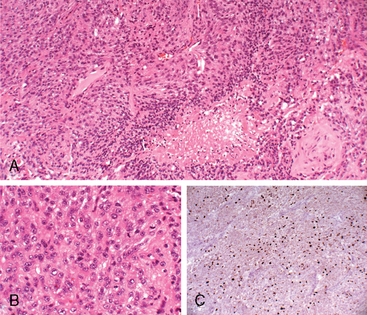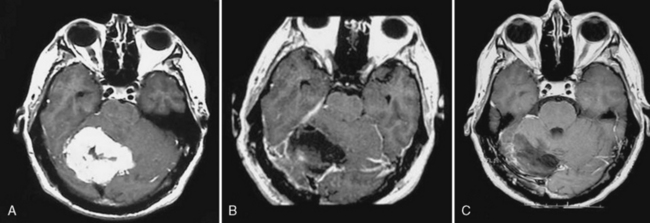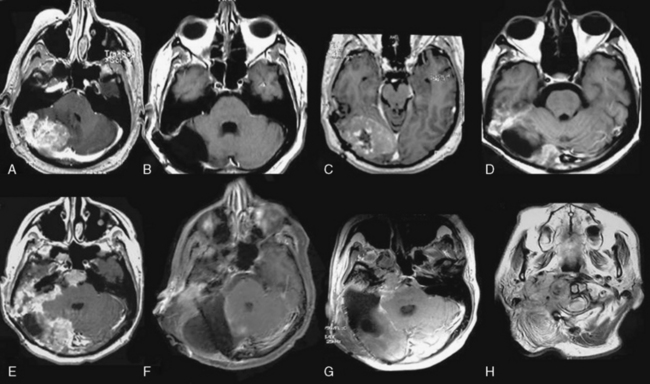CHAPTER 59 Management of Atypical and Anaplastic Meningiomas
INCIDENCE AND PREVALENCE
The annual incidence of meningioma is approximately 6 per 100,000.1 These tumors occur mostly in middle-aged or elderly patients, but they can also occur in younger patients, mainly with neurofibromatosis type 2. Atypical and anaplastic meningiomas represent a small subgroup with histologic and clinical features suggesting aggressive behavior. Owing to the lack of one clear histopathologic classification in the past, there are numerous inconsistencies in the literature. Therefore the rates of atypical and anaplastic meningiomas reported in the literature vary considerably, ranging from 4.7% to 19.8% for atypical and from 1% to 7.2% for anaplastic tumors.1–8 It is known that the prevalence of benign meningiomas is higher in women. In atypical meningiomas there is an equal male:female ratio2,9,10 or even a slight female predominance.11,12 In contrast, anaplastic meningiomas seem to be more common in males.7,9,13,14 Further, atypical and anaplastic meningiomas appear earlier in life.9,13
Most studies either do not present exact data about the location of atypical and anaplastic meningiomas or mix the two types of tumors. Looking at the reported cases one can say that atypical meningiomas are located in 65% over the convexity, the falx, or the parasagittal region, in 31% on the skull base, in 2% on the tentorium, and in 2% in the posterior fossa.3,9–11,15–18 For anaplastic meningiomas, the percentages change to 77% (convexity, falx, and parasagital), 18% (skull base), 3% (tentorium), and 2% (posterior fossa).1,4,9,10,15,16,18–26 Sade and colleagues reported that 75% of atypical and 80% of anaplastic meningioma are found over the convexity and 25% and 20% respectively on the skull base.27 There are only a few reports of atypical and malignant spinal meningiomas, suggesting that tumors in this location have a different pathologic behavior as they rarely show malignant transformation or recurrence even if not totally resected.27–29 The differential meningeal embryogenesis may result in the predominance of one arachnoidal cell type over the other at certain location.27 Metastases for meningiomas are rare, even for anaplastic meningiomas. The lungs are the most common site for seeding but metastases were also found in the bone, liver, skin, and subcutaneous tissue.12,29–31
Atypical and anaplastic meningioma can occur after cranial irradiation for tumors or other conditions, especially in younger patients.32 It is reported that 2% of patients with a meningioma have a prior history of high-dose radiotherapy for intracranial neoplasm, including pituitary adenomas, medulloblastomas, astrocytomas, and acoustic neuromas.12,33 The incidence of 76% benign, 19% atypical, and 4% malignant among radiation-induced meningioma with high-dose therapy and 90% benign and 10% atypical after low-dose radiotherapy is reported.34 As radiation-induced atypical and anaplastic meningiomas show a different clinical course and seem to have different pathologies they are discussed in Chapter 4.
PATHOLOGY
As mentioned, the histopathologic classification or grading of atypical and anaplastic meningioma has been a topic of debate. At present, most studies refer to the 2000 WHO criteria for their classification, which have not changed with the 2007 edition (Table 59-1).14
TABLE 59-1 Classification and grading of meningiomas according to the histological subtype14
| Grade I (benign) | Grade II (aggressive) | Grade III (malignant) |
|---|---|---|
| Meningothelial | Atypical | Anaplastic |
| Fibrous (fibroblastic) | Clear cell | Rhabdoid |
| Transitional (mixed) | Chordoid | Papillary |
| Psammomatous | ||
| Angiomatous | ||
| Microcystic | ||
| Secretory | ||
| Lymphoplasmacyte-rich | ||
| Metaplastic |
Meningiomas are classified as the atypical type if they show increased mitotic activity or three or more of the following histologic features: increased cellularity, small cells with a high nuclear: cytoplasmic ratio, prominent nucleoli, uninterrupted patternless or sheet-like growth, and foci of “spontaneous” or “geographic” necrosis. Increased mitotic activity is defined as 4 or more mitoses per 10 high-power (40×) fields (defined as 0.16 mm2) (Fig. 59-1). Anaplastic meningioma exhibit histologic features of frank malignancy far in excess of the abnormalities present in atypical meningioma. These include either obviously malignant cytology resembling that of carcinoma, melanoma or high-grade sarcoma, or a markedly elevated mitotic index of 20 or more mitoses per the high-power fields (defined as 0.16 mm2) (Fig. 59-2).14 Brain invasion, characterized by irregular, tongue-like protrusions of meningioma cells infiltrating underlying parenchyma, without an intervening layer of leptomeninges, connotes a greater likelihood of recurrence and can occur in histologically benign, atypical, and anaplastic meningioma. It is estimated as an adverse prognostic factor for tumor recurrence and is associated with a significant decrease in survival.35,36
The clinical course and prognosis of atypical and anaplastic meningiomas seem to be heterogeneous.9,10 For example, the clinical behavior of radiation-induced meningiomas differs from similar meningiomas of the same pathologic grade.32 A differentiation or “de novo” atypical and anaplastic meningiomas versus meningiomas with progression has been proposed, as they seem to have different clinical courses.9,35 It is accepted that atypical and anaplastic meningiomas evolve by the accumulation of cytogenetic aberrations and that subsequent genomic changes result in a poorer clinical outcome. The hormone receptor status may also play a role in predicting the outcome. Therefore, a future classification may consider genetic as well as hormone receptor studies as part of the diagnosis.
PROGRESSION
Meningiomas can progress from benign to atypical or anaplastic variants, as is well documented with gliomas.1,2,4,9,24,35 This phenomenon, in which a neoplasm changes irreversibly in one or more characteristics, has been termed tumor progression.37 Such a biologic and clinical progression reflects the sequential appearance of cytogenetically acquired changes.38,39 Glioblastomas can develop de novo or progress from a low-grade or anaplastic astrocytoma termed primary and secondary glioblastoma.14,40 Recently, the differentiation of such “de novo” and “transformed” types of atypical and anaplastic meningiomas has been proposed as they show a significant different overall survival.9,35 Between 0.16% and 2% of all meningiomas experience malignant progression, and the rate of progression in recurring tumors is higher in atypical than in benign meningiomas.2,4,10,24,35,41 Up to 28.5% of recurrent meningiomas transform to malignant varieties,1,2 and the risk of progression from atypical to malignant ranges from 26% to 33%.4,10 The period of time that elapses between the appearance of a tumor and its progression to malignancy is variable. Some describe it shorter for tumors progressing to the anaplastic variant than for tumors progressing from benign to atypical.2 Yang and colleagues found a mean period for malignant progression of 70.0 months from benign to atypical meningiomas and of 89.7 months from benign to anaplastic meningiomas.35 The period of progression from atypical to anaplastic is described to be considerably shorter (39.8 months),35 a fact that is confirmed by other studies.9 Tumors with malignant progression occur in atypical meningiomas in 35% to 38% and in 65% to 70% of anaplastic meningiomas. On the other hand, “de novo” atypical meningiomas occur in 62% to 75% in atypical and 25% to 30% in anaplastic meningiomas.9,35 Meningioma located over the convexities or of the parasagittal location seem to progress more often to malignancy than meningiomas of the skull base.9 The average number of operations performed in meningiomas with malignant progression is higher than in “de novo” aggressive meningiomas, which is due to their more aggressive behavior (Figs. 59-3 and 59-4).
Several studies show that progression in meningioma is associated with cytogenetic alterations and changes in the hormone receptor status, which might also be markers of malignant potential that influence tumor recurrence and poor prognosis.2,42–45
HORMONE RECEPTORS AND PROLIFERATION INDICES
Progesterone receptor expression in meningiomas relates to the tumor’s grade and recurrence. A progesterone receptor–positive status is more frequent in benign than malignant tumors46–48 and there is an association between recurrence and progesterone receptor–negative status.49 Overall survival and tumor recurrence in atypical and anaplastic meningiomas seem to be associated with a high Ki-67 labeling index.50 But significant overlap exists in the ranges for benign, atypical, and anaplastic meningiomas.51 Proliferative indices in progesterone receptor–positive meningiomas are lower than those in progesterone receptor–negative tumors.47,52 Thus, negative progesterone receptor and a higher mitotic activity indicate more aggressive behavior.43,46–49,52 Atypical meningiomas with progression from a benign tumor often have negative progesterone receptor and a higher proliferative index, which may explain the more aggressive behavior than the de novo atypical meningioma.9 Estrogen receptors seem to be more present in atypical and anaplastic meningiomas.43,52
GENETICS
Genetic alterations in meningiomas are known to increase as the tumors become more aggressive.45,53,54 In general, karyotypic abnormalities are more extensive in atypical and anaplastic meningiomas including multiple translocations between different chromosomes and monosomy of multiple chromosomes. In addition to abnormalities of the chromosome 22, which were among the first cytogenetic alterations recognized in solid tumors,14 alterations of chromosomes 1, 6, 9, 10, 14, 16, 18, 19 and sex chromosomes are most often detected in atypical and anaplastic meningiomas.44,53–60 Partial loss or monosomy of chromosomes 1, 10, and 14 is associated with more aggressive behavior in meningiomas.53,54,60–70 Loss of chromosome 18 and loss of part or monosomy of chromosome 10 and an increased monosomy or derivative chromosome 1 in combination with monosomy of chromosome 14, which may represent a bad prognosis, occurs more frequently in meningiomas with progression9 (Fig. 59-5). Two of the most frequent early events in meningioma tumorigenesis involve the loss of expression of the neurofibromatosis 2 (NF2) and 4.1B genes. The 4.1B gene is shown to interact with the tumor suppressor in lung cancer-1 (TSLC1) protein expression, which was shown to be absent in 48% of benign, 69% of atypical, and 85% of anaplastic meningiomas.71 Overexpression of p53, which is probably a surrogate for p53 mutations,72,73 is described to be a predicting factor for the progression in meningioma.35,74,75 It is known that the expression of several genes linked to cell cycle regulation are up-regulated in atypical and anaplastic meningiomas and that expression of several members of the insulin-like growth factor (IGF) and wingless (WNT) signaling cascade is increased in atypical and anaplastic meningiomas with loss on chromosomes 10 and 14, suggesting that aberrations of these pathways may also play a role in progression.76 Cai and colleagues found that the combination of the deletion of 1p and 14q correlated with decreased survival in patients with atypical meningiomas.62











